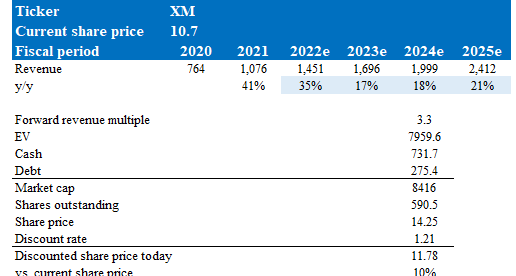VioletaStoimenova/E+ via Getty Images
Investment thesis
I recommend waiting for a cheaper valuation before investing in Qualtrics International (NASDAQ:XM). People, including customers and employees, place a value on the experience they receive from a company. Following the growing need of businesses to collect, monitor, and analyze data based on experience, XM has risen up the ladder in the business world. Due to its superior mechanisms and knowledge base, organizations greatly rely on it.
Business overview
Organizations thrive on data. They need to collect and analyze critical facts and statistics across vital areas. To achieve that, XM has come up with a system that enables it to address the challenges presented by the new economy, which is based on human experience. The XM platform is designed to collect feedback from the four crucial parts of a business: customers, employees, brand, and product. XM converts this data into usable and valuable insight.
Its all about the experience
In the present economy, experience dictates value. When one looks through online reviews about products and services, they find that they are based on the customers’ experiences at the moment of using the product. A five-star review means a good experience, while a one-star review connotes a bad experience.
Effective organizations have recognized this trend. They have learned that we live in a world where experiences, shared and amplified through digital channels, determine the value of brands. Nowadays, changes in how consumers think of a brand can happen very rapidly and dramatically. Both customers and workers have numerous options when it comes to products and companies. Direct commerce, the proliferation of new promotional platforms, and the introduction of new brands have all contributed to lowering switching costs for consumers. Also, in many fields, there are more job openings than job seekers, which means there are more chances to move up in your career.
Companies that can provide seamless, convenient, and amazing experiences are bound to rule their different industries. These companies are deliberately shaping interactions with their customers and employees so that both sides can achieve their objectives. To remain competitive, organizations must understand the impact of experiences: how positive experiences lead to similar outcomes, and vice versa.
This new phenomenon is a big challenge to organizations
Organizations have been awakened to the concept of “experience gaps” and their effects on business growth, that is, the gap between the experience an organization believes it is delivering and the actual experience it delivers. Companies that do not pay attention to and address this problem suffer detrimental results, among which are lost customers, lower spend, complaints, product failures, and poor performance.
In lieu of this, it is paramount to understand the causes of experience gaps, as this will lead companies to make investments in the right direction. With this, the office of the Chief Experience Officer becomes indispensable. The higher echelons of companies, having acknowledged this, now tie C-level compensation to key metrics that successfully close these gaps, i.e., customer satisfaction, product net promoter score, employee engagement, and leadership approval. Market leadership is defined in terms of how quickly and effectively companies can close these gaps.
Systems of record like customer relationship management, enterprise resource planning, human capital management, customer service, and marketing automation are used to collect and report O-data™. It’s true that these platforms are helpful for reporting facts in the here and now, such as pipeline and sales data, employee data, and financial events, but they’re not designed to explain why things are happening.
This means a huge market opportunity for XM. This new category of software has broad applicability to individuals at every level in an organization as it seeks to gain insight regarding the customer, employees, brand, and products. The current vast, rapidly growing market XM inhabits is estimated at a jaw-dropping $44 billion (source: s-1).
Organizations need direct feedback
If any organization will experience growth, competitiveness, and value in today’s economy, then direct, timely, and authentic data is needed. This helps businesses connect with customers at the correct angles, gathering data to fuel their knowledge base. Without this ability to access the customer’s perspective, companies will find themselves at a severe disadvantage. They need a software platform that enables them to develop and maintain direct feedback loops. That is just why XM exists.
XM platform addresses the challenges organizations face
Designed to help organizations measure, prioritize, and optimize the experience that they provide to customers, the XMTM platform offers solutions in terms of Customer Experience, Employee Experience, Brand Experience and Product Experience. These solutions are built on the research core and integrated with the Research on Demand offering. Deploying Qualtrics iQ, the XM platform allows its clients to target the right users at the right moment, harvesting important insights along the way. There are two important factors worth emphasizing:
- XM allows organizations to personalize their communication with customers and partners. I believe customers respond better to emails, SMS, voice calls, and websites that make them feel like they are in a conversation with a real person. This is a stark difference from the rest of the official junk they have been used to. Customers can now connect and interpret this kind of data with the help of XM to help them make better decisions.
- XM keeps timeliness uppermost in the course of its operations. It recognizes that the most important data could become redundant with the passage of time. XM extracts real-time feedback and provides much needed analysis. This quality ensures reduced churn, an increase in sales, the prevention of employee turnover, increased engagement, and the promotion of the company’s brand.
XM is a market leader
As a market leader, the development and innovation that XM has experienced in recent years have been largely due to user insights. It has been able to develop, test, and refine software solutions. At the moment, users across 9,000 organizations rely on the XM software for diverse and workable insights into their businesses.
XM platform’s product advantage
The first advantage XM Platform’s product possesses is its scalability. XMTM has been able to achieve the scalability required by the world’s largest enterprises. Qualtrics has proven to be a wide and easily configurable platform to facilitate a wide array of use cases. An instance of this: Qualtrics now powers over 40,000 dashboards for Walmart managers to track employee experience. Since 2015, Qualtrics has maintained an average uptime of 99.89%.
The second benefit is that XM is able to store, process, and scale massive amounts of data, making it possible to store the vast majority of solutions. The Qualtrics architecture makes it simple to incorporate operational data via APIs, which increases the value of feedback from actual users’ experiences. This information guarantees that XM’s first-rate capabilities in data conversion can be put to use, including sophisticated statistical analysis, text analysis, machine learning, and natural language processing.
Third: The XM technology platform is simple to implement, set up, operate, and expand. Customers from all socioeconomic backgrounds can quickly and easily reap the benefits as a result. The value of the X-data™ generated by initial deployments grows exponentially over time, and as a result, many customers decide to expand their XMTM implementations to take advantage of the growing impact and sway of X-data™ insights.
A powerful GTM strategy to drive growth
To target customers, XM employs an effective and innovative model that combines a prolific sales team (inside and field). Leveraging the Qualtrics Partner Network [QPN], it is able to develop go-to-market opportunities, product enhancement, and service delivery. To demonstrate its focus on profitable delivery, XM measures sales rep productivity to track how close it is to achieving targeted objectives. This enables it to meet customer requirements while managing resources efficiently.
Clarabridge acquisition enhances XM
I believe that Clarabridge greatly enhances Qualtrics’ ability to process unstructured data. Clarabridge’s secret sauce is found in its proprietary collection of over 150 pre-built industry models that analyze conversational data. As of right now, these machine learning algorithms and pre-built multi-level category frameworks support 23 languages and emoji. These models would be able to determine, without the intervention of a human, that a customer has a problem with the online claims process in the property and casualty department if, for example, they call the insurance company to complain. Qualtrics clients can take immediate, accurate action to fix current problems and reduce the likelihood of similar occurrences in the future.
Valuation
My model suggests that XM is fairly valued at its current valuation. My model values XM on a forward revenue basis, as the business is not expected to generate meaningful profits in the near term. The model follows consensus growth estimates, which I believe are achievable given the large TAM and the fact that XM is the market leader. My model does not take into account additional M&As given that XM just conducted a large acquisition last year.
XM is trading at 3.3x forward revenue today, after getting beaten down from a high of 20x last year. While I can agree on this decline due to rising rates and sector rotation, it is tough to imagine it will trade back to 20x. Hence, I simply assumed it would at least stay flat in FY24.
Based on these assumptions, I believe XM’s stock is worth $11.78 today after discounting it by 10%.
Own estimates
Risks
A new industry
The industry is new and rapidly changing, with relatively low barriers to entry. The competition may not be as well equipped as XM; that doesn’t stop them from replicating its situation. The experience economy is a juicy industry, dripping with prospects. This means that more and more companies will be attracted to it as time goes by.
Conclusion
To conclude, I believe XM is fairly valued today. The good thing is that XM is a market leader in the experience economy, with an unmatched ability to collect data and convert it into insights. It also has a product platform advantage, which, compared to other companies in the industry, gives it a greater share of the market. Also, by acquiring Clarabridge, XM has shown that it is ready to dominate the market. All we need now is to wait for a cheaper valuation.


Be the first to comment